The Radio Cabinet
Termite is the wood cabinet, the radio box, greatest enemy. Termites do a silent job, eating the wood until there is no possibility of recovering.
The first step is to check if the cabinet still has termites. The complete termite extermination sometimes is a hard and long process. The most common way is to apply several layers of a specific insect killer, always in a well ventilated place wearing gloves and mask.
When small, the damage caused by the termites can be repaired with acrylic latex wood filler. There are color wood fillers available on the market, in cherry, cedar, mahogany and walnut colors, among others.
Tips: Bigger damages implies on the piece replacement or recovery with glue and pieces of wood. Wood skewers, glued in successive layers with wood glue give excellent results! After “structural” restoration, wood filler and a sandpaper number 300 or 400 will flat the surface.
 The receiver on the side, a Philips BX-665, made in the Netherlands from 1946 to 1948, had its box totally covered by holes, destroyed by termites. To restore it more than one pack of barbecue wood skewers, some more of popsicle sticks and two 250g wood glue tubes were used. The receiver on the side, a Philips BX-665, made in the Netherlands from 1946 to 1948, had its box totally covered by holes, destroyed by termites. To restore it more than one pack of barbecue wood skewers, some more of popsicle sticks and two 250g wood glue tubes were used.
The cabinet had to be painted with brown synthetic glaze, because the amount of repair to be done did not permit a translucid finish. This radio retractile dial is located on the top part and was remade from the original data by professor Ari Zwirtes.
On the pictures below, restoration aspects of the Deso-Dewald radio model 453-D, made in Switzerland in the years of 1944 and 1945. The box was attacked by termites on the front part and internal edges.
On the smaller pictures the front holes filling and the first sanding. On the detail, the tuning indicator working and the “magic eye” (tube EM4) after electronic repair.
 
This set was one among others with no dial. After contacting Deso Dewald Museum (Zürich-Switzerland) original dial pictures were received, what made it possible to remake the dial, also by master Ari Zwirtes.
Tips: Termites can’t resist intense heat or cold. An easy way to exterminate them is to expose the wood to intense sunlight or place it in a very cold place. The risk of sun exposure is wood warping. To small pieces there has been successful use of microwave oven and freezer for 24 hours!
At painting stage, if the boxes show a good surface, it’s possible to apply transparent or colorful glaze, depending on the original color.
On the picture below, a cabinet receiver Pilot H554 restoration, made in USA in 1938. The small termite attack was solved with cedar color wood filler. On the surface it was applied two coats of colorful glaze. Before that, the box has been painted with an unsuitable dark paint.
 
Cabinet's surface can be covered with lacquer, depending on the box state and its original appearance. Lacquer is a high quality translucid covering, which gives a beautiful glassy look. It’s a job to be done by experts.
 On the side, receiver model T 23-BT made by Marconi Co. in England. After selling his North American branch to RCA, Guglielmo Marconi focused on his British companies. On the side, receiver model T 23-BT made by Marconi Co. in England. After selling his North American branch to RCA, Guglielmo Marconi focused on his British companies.
Electronic restoration was hard work, input transformer, capacitors and Mullard tubes from the push-pull replacement. After the chassis painting, the cabinet was sanded and got a lacquer covering.
On the pictures below, a K-53 receiver, made in United States between 1932 and 1933, by General Electric. When I bought, the front wood it seemed “bran”. It did not have the front or the bottom parts, which have been eaten by termites. After restoring the wood to a similar state of what was left from its original texture and color, the pieces were glued (picture on the right) and two transparent glaze coats were applied (picture on the left).
  The display “window” was shaped in acrylic, from the original. This beautiful job was done by a surgeon dentist, including General Electric emblem and brand (detail below). The display “window” was shaped in acrylic, from the original. This beautiful job was done by a surgeon dentist, including General Electric emblem and brand (detail below).

On the pictures below, a Zenith receiver, model 6S 321, made in 1937 in the United States. This radio gave a lot of work on its scheme restoration because of the coils partial destruction. The brass oxidation state was notorious. For polishing, there are products that can improve its look. But I found nothing that compares to human arm and the old steel sponge!
 
Knobs can also be remade. They will be shaped in ordinary plastic or in acrylic, from an original knob. On the cabinet bottom rubber feet or felt adhesive streamers can be fixed.
 
On the pictures above, the restoration steps of a semi-destroyed cabinet by termites. After making sure those termites were exterminated, successive layers of round wood barbecues’ skewers and wood glue were applied.
 
After it was applied wood filler and sanding. Above, there is the piece with the final painting and the adhesive felt feet.
Recovery of wood attacked by termites. Cabinet of Radio RCA model 7T1
(USA / 1936 e 1937)
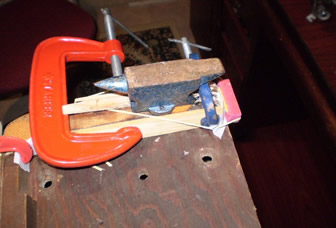 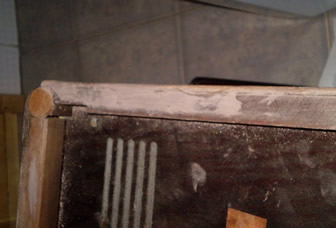
1st Popsicle sticks and matches great with glue and press into place for fastening the cabinet;
2nd Mass for wood in the closest color of the furniture, in this case, mass walnut. Sandpaper No. 200-400;
 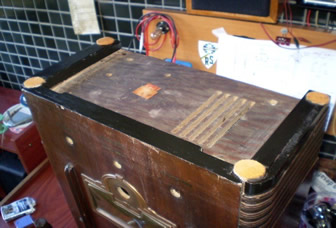
3rd Two coats of automotive paint diluted with thinner. Collage feet felt. Varnish the rest.
Restoration Cabinet Assumption-Philco radio, Model 226T, built in Brazil in the 1950s.
Popsicle sticks and matches, glue and press. After drying, the wood mass, sandpaper and ink.
 
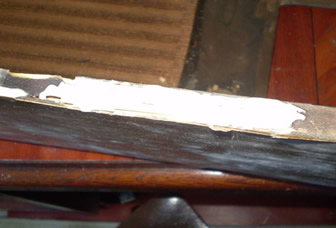 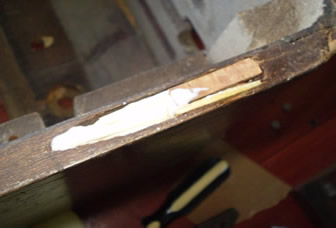
Restoration of the metalic cabinet of Detrola radio, model 568, built in the United States in 1946.
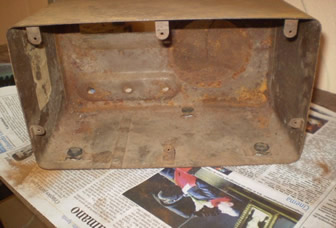 
Sandpaper No. 200-400, with anti rust layer phosphatizant and spray painting.
 
Daltro D’Arisbo
Radio collector and restorer
|